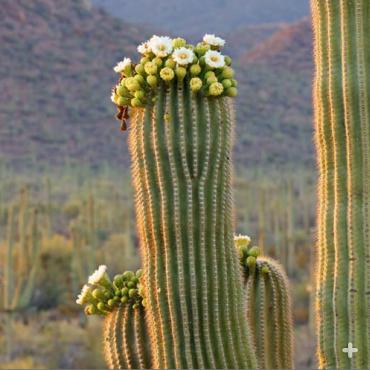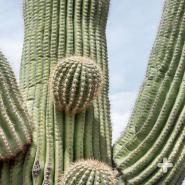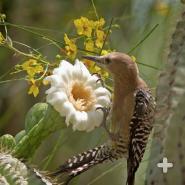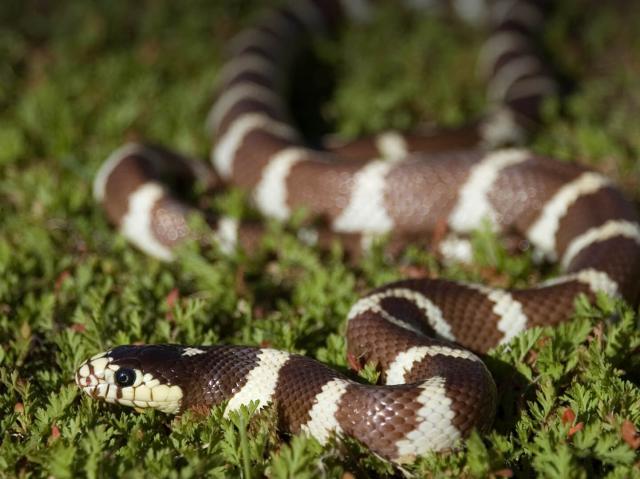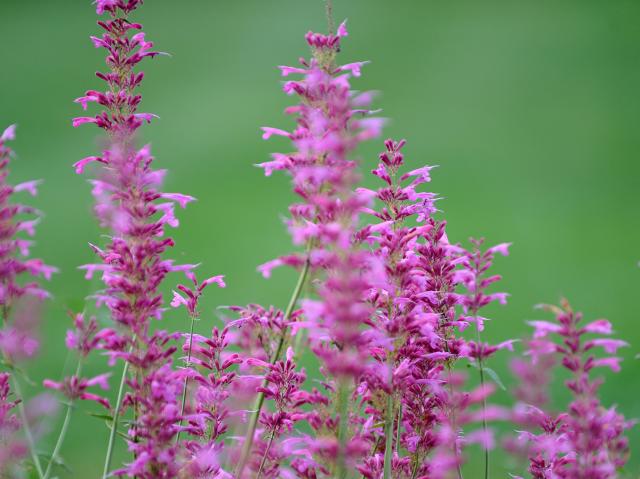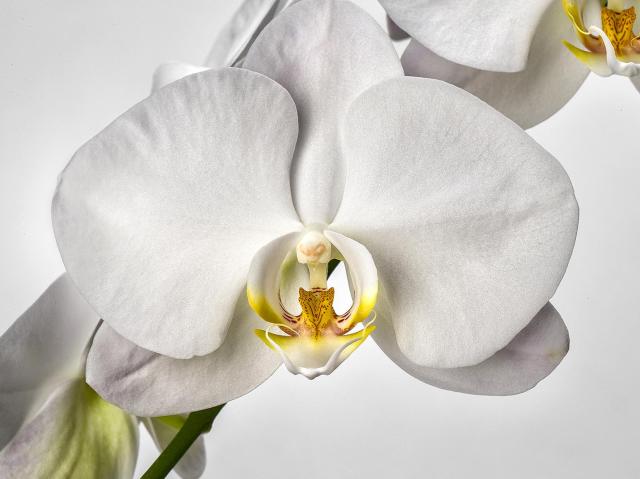
Saguaro

- DIVISION: Tracheophyta
- CLASS: Magnoliopsida (dicotelydons)
- ORDER: Caryophyllales
- FAMILY: Cactaceae
- GENUS: Carnegiea
- SPECIES: gigantea

OVERVIEW
Towering over the gravelly thornscrub of the Sonoran Desert rises what some call the “king of cactuses,” the saguaro. Typically surrounded by creosote bushes, mesquites, and paloverdes, these most iconic of cactuses stand at salute, with arms up as if in a friendly greeting. In fact, the mighty saguaro is a critical component of this ecosystem, welcoming a host of desert wildlife. Woodpeckers and cactus wrens make their cavity nests in it, while many other birds, such as the white-winged dove, feast on its fruit and seeds. Saguaros attract hungry mammals too, including long-nosed bats, jackrabbits, collared peccaries, and bighorn sheep. And they provide home and food for a host of insects, including bees, beetles, and termites. Still other wildlife benefit from the cover a saguaro’s spines provide.
GROWTH PATTERN
If it’s lucky enough to be growing in the shade of a perennial shrub, a saguaro seedling may survive long enough to become a giant. But, at just a quarter-inch (six millimeters) tall, a two-year-old saguaro would go unnoticed in the desert landscape. You’ll have to wait 20 to 50 years for that little cactus to become a prickly, 3-foot (91-centimeter), ribbed cylinder—and even then, it’s just a youngster. Not until a saguaro is about seven feet (two meters) tall will it first bloom. By about 75 years old, most saguaros start to grow characteristic upward-bending, arm-like branches. Some saguaros can live to be 200 years old.
CHARACTERISTICS
Springtime brings saguaro blooms—white, 4-inch (10-centimeter) flowers that open at night and last less than 24 hours. For roughly 30 nights, about 4 flowers open each night. Before the summer rains, large, seedy, sweet fruits ripen—often more than 100 on a single saguaro. Like other cactuses, the saguaro has highly modified leaves that take the shape of spines and grow directly from buds (called areoles) on the ribbed stem and branches. Underground, a three-foot (one-meter) taproot anchors a large saguaro, and lateral roots, just a few inches below the surface, spread out farther than the plant is tall, where they can make the most of quick, heavy downpours.
USES
For thousands of years, indigenous American peoples have used saguaro for ritual and medicinal purposes, as well as for food; and in some places, this traditional harvest continues. The sweet fruits make jam, syrup, and wine. The woody ribs of a dry stem have been used for building walls and roofs, as well as for fencing, furniture, and firewood. Saguaro has also been used as fodder for livestock.
CONSERVATION
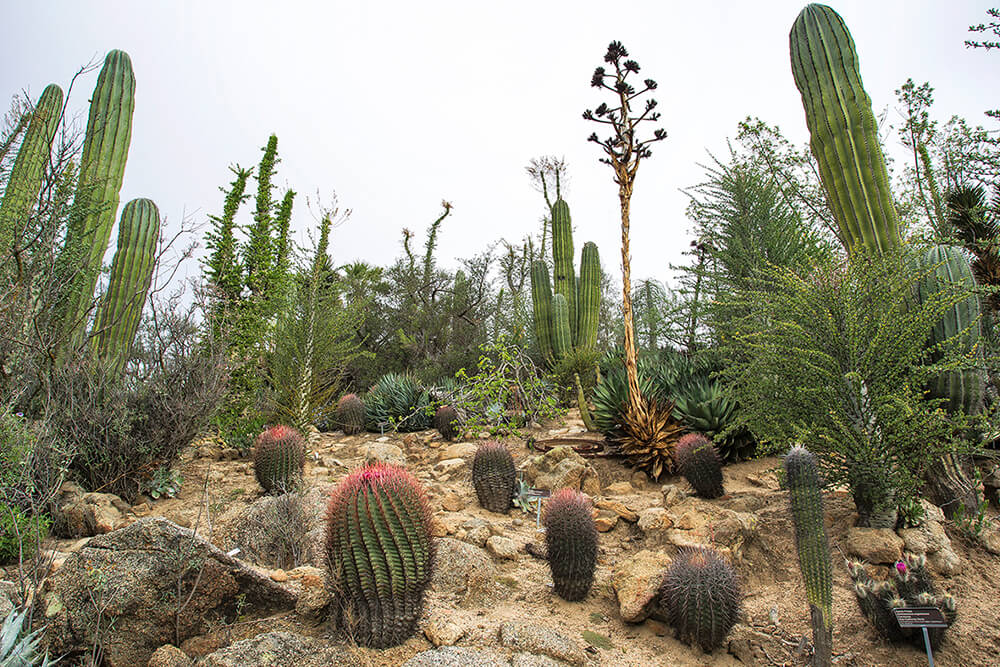
Over much of its range, the saguaro population is declining. The California Native Plant Society places saguaro on its Inventory of Rare and Endangered [in California] Plants. The Arizona Native Plant Law protects saguaros, while allowing for traditional fruit harvesting by people of the Tohono O'odham Nation. In Mexico, saguaro is legally protected, too. Still, poachers indiscriminately collect and sell live plants as well as woody saguaro ribs. Saguaro populations face other threats, too. Invasive buffelgrass competes for space and provides fuel for wildfires. In the US, the biggest threat may be urbanization; and in Mexico, livestock browse on the shrubs that shelter baby saguaros. In areas that have been protected from livestock grazing for 50 years or more, saguaro has increased by 33 to 200 percent.
By supporting San Diego Zoo Wildlife Alliance, you are our ally in saving and protecting wildlife worldwide.
TRIBUTE
This cactus’ genus name Carnegieais a tribute to industrialist-philanthropist Andrew Carnegie. The Carnegie Institution for Science, which he founded and endowed, established the Desert Botanical Laboratory in Arizona in 1903.
GIANT
A saguaro’s species name giganteais a reference to its immense size. The largest cactus species in the US, big specimens can reach 50 feet (15 meters) tall, 30 inches (76 centimeters) in diameter, and weigh more than a ton (907 kilograms).
STATE FLOWER
The saguaro blossom is the state flower of Arizona.
OUR COLLECTION
Look for saguaros at the Safari Park—in the Baja Garden and the California Nativescapes Garden.
PLEATS
A saguaro’s accordion-like pleats expand and contract as the plant absorbs and loses water.
RAIN
For a saguaro, there are two short rainy seasons—one in summer and another in winter. It thrives on an average of 6 to 15 inches (152 to 400 millimeters) of rain per year. Saguaros do most of their growing during the summer rainy season.


